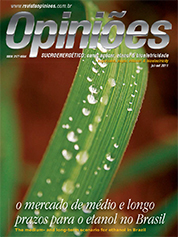Luiz Gustavo Junqueira Figueiredo
Commercial Director of Usina Alta Mogiana
Op-AA-29
Alternatives for the government to regulate the ethanol market
Brazilian ethanol recently began to be monitored by the National Petroleum Agency, according to a provisional bill enacted by the federal government. In addition, the Brazilian government committed to defining policies that will result in more stability in a market that processes almost 30 billion liters per year in the country.
It is a complex task, mainly when considering that the sugar market is free, with Brazil ranking as the product’s largest producer and exporter in the world. Since almost half of Brazil’s sugarcane is destined to this important commodity, ethanol is left with the mission of dealing with the highs and lows of this market, in which price volatility is enormous.
With the recent increase in the number of flex-fuel vehicles and our incapacity to increase the refining of gasoline, the government has induced producers to prioritize the production of ethanol, while at the same time investing in the increase of the production capacity to meet future demand.
We know that the reduction of the volume of ethanol mixed to gasoline runs in the other direction, since it assumes the importing of gasoline from the international market and discourages investments in this industry, while also damaging our image as a reliable supplier of ethanol to the world.
The obligation of contracting anhydrous ethanol in the trade relation between fuel distributors and producers is an important step, because it considerably decreases the lack of product in the off-season. Such contracts are usually celebrated between the mills and the large industrial sugar consumers, with excellent results for both parties.
Any additional purchase need that cannot be met in such a manner would be handled by the international ethanol market through imports or even by export contract washouts, thereby maintaining the mandatory mixture of 25% of ethanol in gasoline.
One of the available alternatives to diminish price volatility would be to use modern mechanisms of future markets that we nowadays have available. We know the supply of ethanol is abundant during the harvest, reducing prices and making producers destine a part of the production to sugar.
This results in a lack of the product in the off-season, with a strong increase in prices that upsets consumers and interferes with the inflation containment policy in the country. The availability of credit for mills to build up inventory during the harvest, albeit useful, has proven insufficient to prevent price levels from escalating.
A supplementary instrument to credit availability policies would be to undertake minimum price auctions. The government would promote auctions to guarantee an attractive price for the producer during harvesting, resulting in that the industry would achieve better margins and thus increase production.
Producers, in turn, would commit before the government to limit prices in the off-season, thereby attenuating a possible future price shock. Such auctions need not involve inventory, making the process quite efficient and immune to fraud. It would be a straightforward financial transaction, guaranteed and endorsed by BM&F/Bovespa, which currently has celebrated an ethanol contract, and which would operate as a clearance chamber with respect to price adjustments.
The cost to the government would be zero because sales revenues from the harvest’s minimum price options (“puts” in the market’s terminology) would be offset by expenses incurred with the purchase of options during the harvest (purchase options or “calls”).
In the event of excessive price increases, the government would become a creditor of the stock exchange, receiving the entire difference between the price agreed upon with the producers and the market price.
This would afford domestic supply a high degree of normality, because it would be a situation producers would want to avoid at all cost, given that with a defined maximum price level there would be no reason for their seeking to exceed it.
Let us assume that the price floor were R$ 1,200.00/m3 (base Paulinia, without taxes) and the maximum R$ 1,300.00/m3. It would be highly unlikely that the market would operate outside the band, for the reasons mentioned above.
By practicing one of these mechanisms, we could finally guarantee ethanol the status of a well-balanced and attractive commodity, resulting in new investments in industrial capacities, creating jobs and helping prevent abusive price increases. In short, a situation to the liking of producers, consumers and the federal government.




